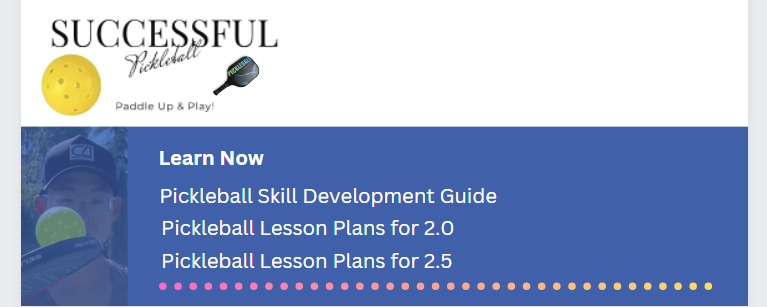DETERMINING THE SERVING TEAM
A coin toss or paddle spin or other fair method can be used to determine which team has first choice of side, service, or to receive.
STARTING THE GAME

At the start of any serving sequence, the player on the right (Deuce court) always begins. When players face the net, the side of the court on the right is known as deuce court, the left is the AD court.
Player positioning is very important in pickleball. The first server must serve from the correct side of the court, the scores 0,2,4,6,8,10 etc. will reflect who started on the right side or who the receiver was at the start of the game.
After the coin toss, it is determined that Team 1 will start the game with the serve.

Positioning & The 2-Bounce Rule
Notice that all the players except 1 is behind the baseline. Both players on the serving team are behind the baseline and should stay behind or near the baseline until the return of service – Why? In case the return of service is deep. The ball must bounce before the service team can make contact and execute the third shot.

Notice that team 2 has a split in the team. The receiver or Player C is behind the baseline incase the serve is deep. Player A must serve the ball into the right court and Player C must allow the ball to bounce before executing the return. Player D is up near the Non-Volley Zone (NVZ) and has a significant role during the serve — it is to watch for line faults.
The 2-ball bounce rule means that both teams must play the ball after the ball bounces (ground stroke) once in either court, only then can a volley (hit the ball before it bounces) during play.
Calling the Score
Players must always start each point by calling out the score. There are 2 reasons why:
- To prepare the other team for start/continue play
- Best way to avoid disputes.

There are always three numbers called in the score:
- The first number is the score of your team,
- Second number is the score of your opponents,
- Third number is the server number.
Score at the start of the game is 0 – 0 – 2. Why?
The rule was implemented to ensure that the team who serves first doesn’t have an unfair advantage. The starting team is only allowed one fault before loss of service.
Failing to Call the Score
If the server fails to call the score, there are three options available to the other team:
- They can let the service pass without making contact with the ball,
- Catch the ball,
- Play on as if the score was called.
Scoring
Teams can only score points when serving.
In our example, the starting team scores a point after the first serve:

Team 1 Player A moves to the left or AD Court & Player B moves to right or the Deuce Court while Team 2 switches positions. Player D now moves to baseline to receive serve. Player C moves to NVZ & watches for serve violations
Team 1 Player A will say the Score “1-0-2” before serving.
(one point for team 1, 0 points for team 2 and it is the second server)
If team 1 fails to earn another point, Team 2 will now get the opportunity to serve.
Side Out
In our Example, the serving team (Team 1) lost their opportunity to serve via a fault – The opponents or Team 2 now serves.

The server is now Player C & the score before the serve will be stated as: “0-1-1”
The serving (team 2) does not have a point (0), their opponents (Team 1) has (1) point, and the first server on team 2 is now serving (1).
Winning a Rally or Scoring a Point

In our example, team 2 (serving team) scores a point or wins the very next rally in this scenario, the score will be “1-1-1” and the server – player C, will move to the AD court.
Score: Team 2 has 1 point, Team 1 has 1 point and it is the still the 1st server for Team 2

Player C will continue to serve and earn points until a fault is made by team 2.
Loss of Service
In our example, the next point, the current serving team (team 2) has a fault. The ball now moves to the second server on Team 2 and the score before the serve is: “1-1-2” (Each team has a point, and it is the second server).

Side Out
In our example, Player D did not earn a point so the ball will now move back to Team 1, player B. Player B is now the 1st server and will say the score 1 – 1 – 1 meaning each team has a point and player B is the 1st server. Player D will receive for team 2.

Remember, player positioning is very important in pickleball. The first server is now on the left or ODD side of the court so the score matches their position – it is the correct side because the score is odd or 1,3,5,7,9, etc. and reflects that player A & player C, who started the game on the right side are now on the left side of the court.
Winning Points
Lets move on in our example. Let’s say Team 1 has earned 5 points and player A is currently the second server, while team 2 has earned 10 points so far in this game.
Can you fill in the blanks?

Remember that teams can only score points when serving and a typical regulation games goes to 11. The Answer is at the bottom of the article.

Faults & Line Calls
A fault on the pickleball court is a violation of the rules. Play stops. The team committing the fault will lose the rally. Faults can be committed on the serve in pickleball. A fault by the serving team results in the server’s loss of serve or side out.
The basic pickleball line call rules are if the ball lands in the correct service court on the serve and within the lines around the service court. The ball is called “out” and it is a fault if the ball lands on the NVZ line or outside the designated lines.
If you are unsure whether the ball is in or out, call it “IN”.
Service foot faults can be called at the moment in time when the server’s paddle makes contact with the ball. If one foot crosses the baseline or any area inside the court at the point of contact with the ball a fault will be called. If the server steps on the area on or outside the imaginary extension lines within the sidelines or centre line a fault will be called.
For more information see the USAPA Official Rules
Answer:

Player A is second server with a score of 5. which is left or odd court (1,3,5,7,9). Team 1 (players A & B) need to get 7 points to win. Why? 2 point differential unless otherwise stated. If they do, the result would be 12-10 for the win.
Current Scenario
In this scenario, the current score is 5-10-2. Both teams are in the correct positions with Player C on the right or even court (2,4,6,8, 10). Player D is receiving the ball and is on the left or ODD court.
In scenario 2, if team 2 can get a side-out they will have 2 chances to win. Player C will serve with the score being 10-5-1. Failing to get a point, Player D can also serve for the win (10-5-2) . If they get 1 point the final score will be 11-5, game over!

Congratulations if you got the right score and position sequence!
Look for Stacking Tips in March 2023!

Please consider subscribing to my blog for more great pickleball content and make sure to follow me on Facebook Grab your dynamic warm-up exercise eBook as well, happy training!











































One response to “Doubles Scoring in Pickleball”
[…] Serving, every point in a pickleball game starts with a serve. The serve provides many opportunities to set up your […]
LikeLike